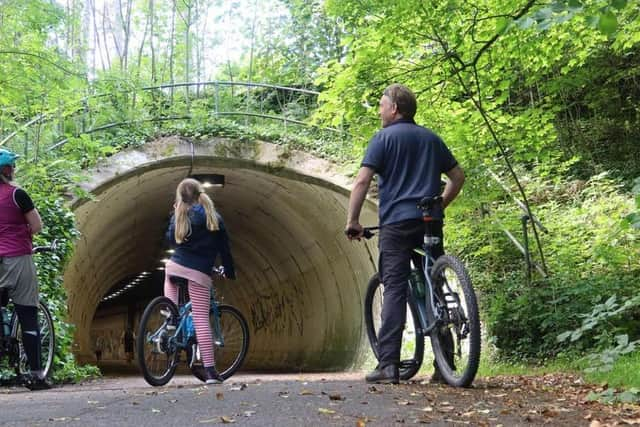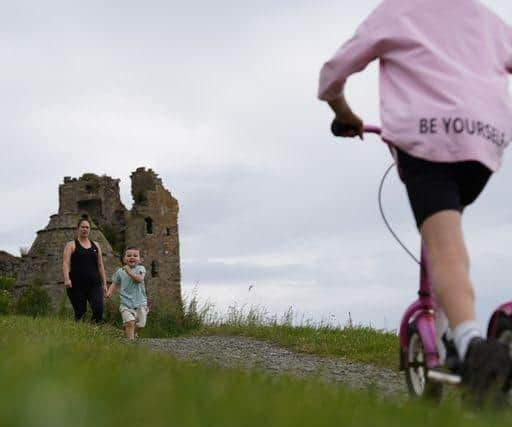New Culzean Way bike path in Ayrshire could create ‘one of the most picturesque cycling routes in the world’
Cycling in much of rural Scotland can be unattractive because of the lack of traffic-free routes enabling riders to avoid busy roads and vehicles travelling at high speeds.
Large areas of the country are far from the 1,643-mile national cycle network, less then half of which is off road and which does not extend west of the Great Glen on the mainland.
Advertisement
Hide AdAdvertisement
Hide AdThe network also shrank by 40 per cent after a review five years ago, when more than 1,000 miles of formerly quiet roads were “reclassified” because of an increase in traffic, vehicle size and speed. That left them deemed no longer safe for a 12-year-old to cycle unaccompanied – one of the network’s benchmarks.


Cycle and footpath developers Sustrans said it hoped to develop the network “at pace and at scale”. However, it was unable to provide details of any projects to extend the network despite launching a feasibility study into filling gaps five years ago.
The Scottish Government’s official development body Cycling Scotland said creating segregated routes was a “top priority”, particularly in rural areas where vehicle speeds were higher.
Transport Scotland agreed "safe, accessible infrastructure is the biggest priority – spaces where people can confidently cycle whether as part of the road network or separate”.
Among those helping to spearhead new routes are campaigners in South Ayrshire who hope to create a new off-road path on a former railway line that could become “one of the most picturesque cycling routes in the world”.


The Culzean Way would connect Ayr and Girvan by using the track bed of the 20-mile former Maidens and Dunure Light Railway and link with the existing Ayrshire Coastal Path. A short section of railway has converted through Alloway, where Robert Burns was born.
The proposed route would also pass Culzean Castle and the village of Dunure, which was a filming location in Outlander.
Film-maker and author of Bikepacking Scotland, Markus Stitz, has made a video commissioned by the South Ayrshire Paths Initiative (SAPI) to promote the project.
Advertisement
Hide AdAdvertisement
Hide AdHe said: “Giving this disused coastal railway route a new lease of life would create one of the most picturesque cycling routes in the world. Spending five days in this beautiful part of Scotland inspired me to not only produce this film, but also to give South Ayrshire pole position in my latest book.”


SAPI secretary Bill McKinlay said: “For many years, I’ve looked at the curves of this old railway line sweeping along the South Ayrshire coast, with magnificent views of Arran, Ailsa Craig, Kintyre and Northern Ireland as its backdrop.
“I’ve viewed it from the car, or while risking life and limb cycling on the road, and it’s long been my dream to walk and cycle the route. So many disused railway track beds have been re-purposed as active travel routes and this one would rival any for location and scenery.
"It will be a superb facility for people living in the area, and a boon for tourism. We’re finally getting close, with funding available, a political will to make it happen, and now this wonderful film from Markus to showcase the concept.”
Spokes, the Lothian cycle campaign, applauded the Culzean project. Ian Maxwell, from the group, said: “Disused rail lines can provide an ideal cycle path for very little expenditure. Even if eventually there is a need to reinstate the railway, it's far better to create cycle paths on them now. Every busy road should have have an alternative cycle path available.”


His colleague Dave du Feu said: “Within Edinburgh, the cycle network on old railway lines has helped preserve their integrity and the city council has been pretty clear that if the tram is extended along the Roseburn route, then a parallel walk/cycle route will be a requirement.”
Mr du Feu said he thought the cycle route created on the route of the Airdrie-Bathgate rail line after it closed had helped prevent it from being built over, assisting its restoration in 2010, when a replacement parallel cycle route was created.
A Cycling Scotland spokesperson said: “The top priority for safer cycling is to create more dedicated networks of cycle lanes. Separating people cycling from people driving is particularly important in rural areas, where 60mph roads create even greater risks.
Advertisement
Hide AdAdvertisement
Hide Ad"People living in rural areas should be able to safely undertake local journeys by bike to school, shops or public transport. The ever-growing climate emergency means everyone needs to be able to cut emissions, including travelling more by bike, and we need to accelerate progress on building the cycle networks across Scotland.
“The development of electric bikes means longer journeys of five to ten miles become possible for more people by bike, and rural paths can greatly enhance tourism, supporting local businesses.
“Where rail lines were lost to the Beeching cuts [in the 1960s], adapting these routes as cycle paths can help protect them from development and make it easier for lines to re-open where there is the demand to do so.”


A Sustrans spokesperson said: "We are working to develop and improve the national cycle network, making it more consistent, safer, accessible and easier for people to walk, wheel and cycle.
“We hope that developing the network at pace and at scale will inspire and encourage more people to leave their cars at home and make healthier, happier and more sustainable choices more often. Routes which connect rural communities are a hugely important part of this."
The spokesperson said it was aware of SAPI’s plans, but had yet to receive any funding request for a feasibility study.
Transport Scotland said it had more than doubled spending on extending and improving the national cycle network to around £14m in the year to next March compared to two years ago, but did not provide any details of how the money would be spent. Its spokesperson said an “active travel transformation project” was underway to consider how best to complete future projects.
Comments
Want to join the conversation? Please or to comment on this article.